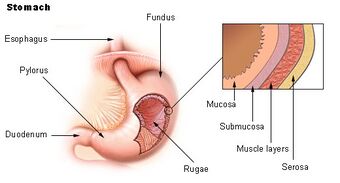Medicine:Chronic gastritis
| Chronic gastritis | |
|---|---|
 | |
| Mucosal layers of the stomach |
Chronic gastritis is a chronic inflammation of the gastric mucosa.
Signs and symptoms
Many people who have chronic gastritis do not experience any noticeable symptoms. Those who do, claim to experience one or several of the following: upper abdominal pain, indigestion, bloating, nausea, vomiting, belching, loss of appetite, and weight loss. Stomach bleeding or black stool has been reported in extreme cases.[1]
Cause
- Bacteria (Bacterial gastritis)
- Helicobacter pylori (Helicobacter pylori-associated gastritis)[2]
- Bile reflux. In some cases, bile, normally used to aid digestion in the small intestine, will enter through the pyloric valve of the stomach if it has been removed during surgery or does not work properly, also leading to gastritis.
- HIV/AIDS
- Crohn's disease (Crohn gastritis)
- Celiac disease (lymphocytic gastritis)[3]
- connective tissue disorders
- liver failure
- kidney failure
Pathophysiology
Chronic gastritis is a progressive, life-long inflammation. It usually begins in childhood with superficial mononuclear inflammation and acute neutrophilic inflammation in the gastric antrum and fundus. It progresses to atrophic gastritis with loss of normal mucous glands. This results in the loss of iron, calcium, magnesium and zinc absorption. The loss of mucous glands resulted in the growth of immature glandular and epithelial cells resembling the glands in the small bowel or colon (intestinal metaplasia) which can cause gastric adenocarcinoma through intraepithelial neoplasia.[2]
H. pylori infection is the most common form of chronic gastritis. In the beginning, the involvement tends to occur in either an gastric antrum, then progressive spreading to the gastric fundus, where the whole gastric mucosa is involved or with the sparing of certain parts of gastric mucosa. This resulted in the progressive reduced secretion of gastric acid and finally absent gastric acid secretion. The H.pylori infection may fade off in the absence of gastric acid secretion but gastric adenocarcinoma may gradually kick in. The yearly risk of progressing from one step to the next is 2 to 3%.[2]
Diagnosis
Classification
Since 1992, chronic gastritis lesions are classified according to the Sydney system.[4]
Treatment
References
- ↑ "Chronic Gastritis". http://www.healthline.com/health/gastritis-chronic#Symptoms2.
- ↑ 2.0 2.1 2.2 Pentti, Sipponen; Heidi-Ingrid, Maaroos (3 June 2015). "Chronic gastritis". Scandinavian Journal of Gastroenterology 50 (6): 657-667. doi:10.3109/00365521.2015.1019918.
- ↑ Brown, I. S.; Smith, J; Rosty, C (2012). "Gastrointestinal pathology in celiac disease: A case series of 150 consecutive newly diagnosed patients". American Journal of Clinical Pathology 138 (1): 42–9. doi:10.1309/AJCPE89ZPVJTSPWL. PMID 22706856.
- ↑ "Gastritis". MayoClinic. April 13, 2007. http://www.mayoclinic.com/health/gastritis/DS00488/DSECTION=causes. Retrieved 2008-11-18.

